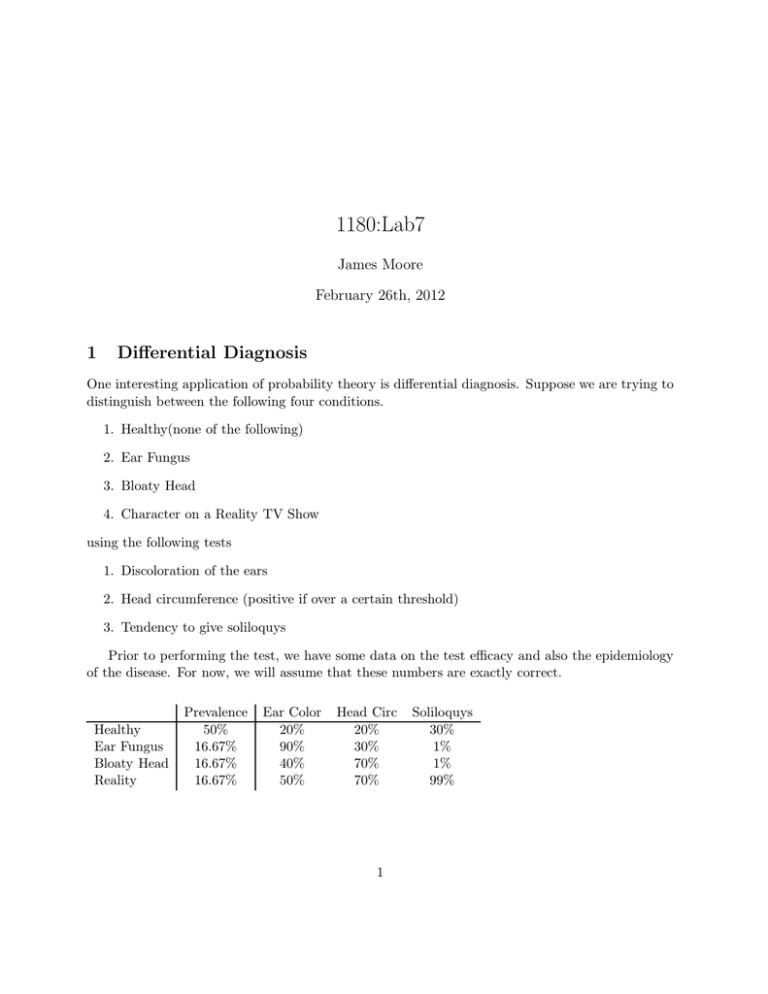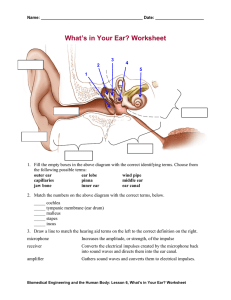1180:Lab7 1 Differential Diagnosis James Moore
advertisement

1180:Lab7 James Moore February 26th, 2012 1 Differential Diagnosis One interesting application of probability theory is differential diagnosis. Suppose we are trying to distinguish between the following four conditions. 1. Healthy(none of the following) 2. Ear Fungus 3. Bloaty Head 4. Character on a Reality TV Show using the following tests 1. Discoloration of the ears 2. Head circumference (positive if over a certain threshold) 3. Tendency to give soliloquys Prior to performing the test, we have some data on the test efficacy and also the epidemiology of the disease. For now, we will assume that these numbers are exactly correct. Healthy Ear Fungus Bloaty Head Reality Prevalence 50% 16.67% 16.67% 16.67% Ear Color 20% 90% 40% 50% Head Circ 20% 30% 70% 70% 1 Soliloquys 30% 1% 1% 99% 2 Questions Use probability theory to find the following. 1. The probability that someone tests positive for ear discoloration. 2. The probability that someone tests positive for large head circumference. 3. ...for soliloquys. 4. Suppose that has discolored ears. Use conditional probability to find the probability that they are:Healthy, suffering from ear fungus, have a bloaty head or are a Reality TV Star. 3 Simulating Lots of Tests To gain some insight into how these tests work together we will simulate a population of 10000 people, run each test on them and then examine the resulting data. Disease_Names=c("Healthy","Ear Fungus","Bloaty Head Disease","Reality TV Contestant") Incidence=c(50,16.67,16.67,16.67) N=10000 #Number of Patients #Positive for Test A (Ear Color Test) A_pos=c(.2,.9,.4,.5) #Positive for Test B (Measure Head Circumference) B_pos=c(.2,.3,.7,.7) #Positive for Test C (Random Soliloquys) C_pos=c(.3,.01,.01,.99) #Generate Diseases D_Numbers=sample(1:4,N,prob=Incidence,replace=T) #Match Numbers to Hilarious Names Diseases=Disease_Names[D_Numbers] #Simulate Tests A_result=rbinom(N,size=1,prob=A_pos[D_Numbers]) B_result=rbinom(N,size=1,prob=B_pos[D_Numbers]) C_result=rbinom(N,size=1,prob=C_pos[D_Numbers]) 2 #Put in a data frame Patients=data.frame(Diseases,A_result,B_result,C_result) The variable ‘Patients’ contains all of our data. Trying to read through it would be a waste of time. Instead we can count the numbers of people with weird looking ears. > sum(Patients$A_result) [1] 3983 Then we can get a breakdown of the conditions of all those people. > summary(Patients[A_result==1,"Diseases"]) Bloaty Head Disease Ear Fungus 665 1483 Reality TV Contestant 853 Healthy 982 For my data, I see that 37% (1483/3983) of people who test positive for ”Ear Discoloration” actually have Ear Fungus. This number will be different for you. Next we can look at all the people who have Ear Fungus but don’t give soliloquys. First here’s the breakdown. > summary(Patients[A_result==1&C_result==0,"Diseases"]) Bloaty Head Disease Ear Fungus 655 1469 Reality TV Contestant 7 Healthy 696 Then we can sum this list to get the total number of people positive for one test not the other. > sum(summary(Patients[A_result==1&C_result==0,"Diseases"])) [1] 2827 With both test results, the odds have improved to 52% (1469/2827) 4 More Questions! 1. Check all your answers to the first part using the simulation data. Give your prediction along with what the data tells you both as raw numbers and a percentage. 2. We have three tests meaning there are 8 possible outcomes. (All Negative, All positive, Only one test positive (3), Only one test negative(3)). For each case, give the most likely condition (healthy, ear fungus,etc) and how likely it is to be that disease. (There’s another page!) 3 3. Add one new test and one new disease to the list. Adjust the prevalence so they still add up to one 100% and make the test outcomes whatever you want (can’t be less than 0 or more than 100%), but be sure to provide them. In addition, modify the code and include it in your final document. Run a simulation and then pick one hypothetical series of test outcomes. Can you figure out what the patient has? 4
